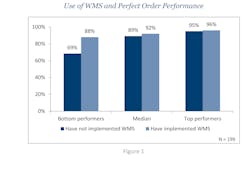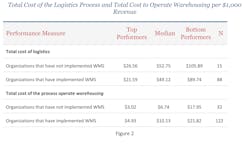Improve Efficiency within the Warehouse
Warehouse management systems (WMS) integrate warehouse functions and provide greater inventory visibility, which can lead to more efficient warehouse operations. Organizations may wonder: What is the impact of investing in WMS? Does the data-intensive nature of WMS lead to higher costs? Do WMS provide a substantial return on investment?
Results from APQC’s Open Standards Benchmarking in logistics show that organizations using WMS have more efficient and accurate warehousing processes and lower overall logistics costs, although the cost to operate warehousing at these organizations is higher than at organizations without WMS.
Warehouse Efficiency
Organizations that have implemented WMS report higher perfect order performance than organizations without these systems (Figure 1). The results indicate that organizations using WMS are better able to deliver customer orders on time, complete, without damage and with accurate documentation. The difference in performance between the two groups is 4% at the median, which is significant from a customer-facing standpoint.
Organizations that have implemented WMS also report a lower amount of expedited orders than organizations that have not implemented WMS. WMS can help reduce expedited orders, especially when they are fully integrated with other business systems such as enterprise resource planning (ERP), transportation management, automatic order picking and radio frequency identification (RFID) systems.
The perfect order performance and amount of expedited orders achieved by organizations with WMS could be tied to the visibility provided by the technology. The integration of warehouse functions into one system enables staff to quickly pick and ship products. A centralized inventory reduces the chance that product is unavailable to send to a customer, which in turn can increase on-time deliveries and reduce expedited orders.
Yet efficiency is not the only factor to consider when evaluating WMS. Organizations must also gauge the impact of WMS on logistics and warehousing costs to determine whether these systems are the right investment.
Logistics Costs
APQC’s data reveals interesting results when comparing the logistics costs of organizations that have implemented WMS to the costs of organizations that have not. Figure 2 lists the costs of the logistics process as a whole and the costs of operating warehousing per $1,000 in revenue for both groups of organizations.
At the median, organizations using WMS spend $3.63 less per $1,000 revenue for the entire logistics process than organizations that do not. For an organization with $5 billion in revenue, this would translate into a difference of over $18 million per year.
Although organizations with WMS spend less on the logistics process as a whole, they spend more to operate warehousing. At the median, the difference in cost for the two groups of organizations is $3.39 per $1,000 revenue. The higher cost for organizations using WMS could be linked to increased systems costs related to implementing and maintaining the system, storing data and training employees to use the system. These additional costs could be offset by a reduction in total logistics cost brought about by greater efficiency.
Tailor the Solution
APQC’s data shows that organizations with WMS have more efficient warehouse operations and spend less on logistics despite spending more to operate warehousing. Several factors can affect the decision to implement and maintain WMS. The number of employees needed to use and maintain the system must be considered, as well as whether such a data-intensive solution would place too many demands on an organization’s infrastructure.
WMS can lead to logistics benefits, but organizations must make sure the adoption and configuration makes sense for their needs.
APQC is a member-based nonprofit and a proponent of benchmarking and best practice business research. Working with more than 500 organizations worldwide in all industries, APQC focuses on providing organizations with the information they need to work smarter, faster and with confidence.






